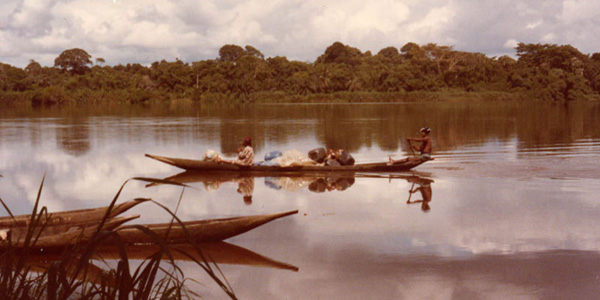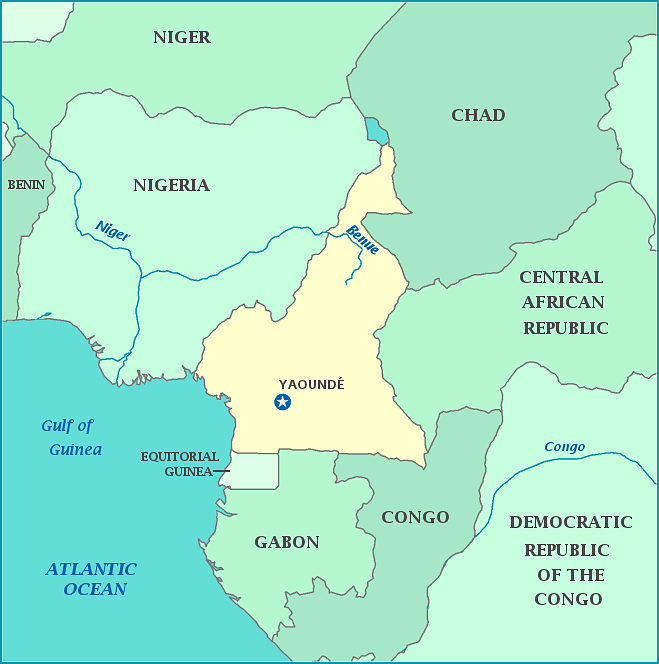The
only thing I really knew about Cameroon before doing this was that its name
came from the Portuguese’s term for the area, Rio dos Camarões, or River of
Shrimp. Although, it has always
made me wonder. The word camarões,
meaning shrimp (plural), is pronounced roughly /ka-ma-roe-esh/, yet the word
for shrimp (singular), camarão, is
pronounced /ka-ma-rown/. The singular word is by far closer to the name of the
country than the word in plural. Well, anyway, I’ve pondered this for the past
seven or eight years. (Yes, sadly, it’s true. These are the sorts of things I
think about on my 45-minute commute to and from work.)
Camaroon
is located on the Atlantic side of the African continent right in the bend (where
I always think where South America broke off of). It’s surrounded by the countries
of Nigeria, Chad, Central African Republic, Congo, Gabon, and Equatorial Guinea
and lies on the Bight of Bonny and Bay of Guinea. The capital city is Yaoundé,
which lies inland a bit and has about 1.4 million people. However, the largest
city is the coastal city of Douala with about 2 million people.
The
original peoples were Baka (Pygmies), and then the Bantu migration spread into
this area as well. The Bamum
people actually developed their own writing system, a feat not often found with
many peoples. There are a myriad of indigenous languages in Africa, and many of
these are spoken-only languages, so what the Bamum people did was unique in my
opinion. I certainly don’t know if they were the first, but I certainly doubt
they’re the only ones. The Bamum script from an amateur point of view appears
to be a mix of Greek, Arabic, and Runes.
In the 1880s, the German Empire took control of the area and
created the colony called Kamerun, but after WWI, it was divided between the
British (called British Cameroons) and the French (called French Cameroun). The
British kept control of their colony from neighboring Nigeria, and when
conflicts started to arise because of this, they were faced with the decision
of whether to join French Cameroun or unite them with Nigeria. In 1960, French
Cameroun broke away from France and declared its independence. A year later,
British colony of Southern Cameroons joined them.
Cameroon has been described as “Africa in miniature” for
representing all of Africa’s climates and landscapes in one country. It has a
coastal region with rainforests, savannas and deserts, all the way up to
mountainous regions. Some of the coastal forests are considered some of the
wettest places on earth. The southern areas lie on a set of plateaus and
include some of the country’s most fertile soil. Cameroon does have its own
active volcano, Mount Cameroon (the highest mountain in West Africa), which has
left the area surrounding it scarred with crater lakes. Lake Nyos is one of
these lakes which spewed a deadly amount of carbon dioxide enough to kill
1700-2000 people during the summer of 1986. There are two other lakes like
this: Lake Monoun about 60 miles away from this one and Lake Kiva in Democratic
Republic of the Congo. It’s caused when the gasses from the magma and lava
floes rise up and violently mix with the groundwater of the lake. Scientists
have been working on ways to control the release of these gasses so that it
doesn't cause another disaster like this one, although other violent releases
have taken place, just not to the scale of the 1986 incident.
Because Cameroon was controlled by both the British and the
French, there are a large number of followers of Christianity; however, like
many other African countries, these same followers also still practice their
indigenous animist beliefs as well. There is also a smaller but sizable number
of Muslims as well.
The official languages of Cameroon are French and English
with French being the dominant language. German is no longer used, and there
are many local languages and dialects that are also spoken as well, creating
the need for a Cameroonian Pidgin English as a lingua franca amongst the
peoples (as well as Camfranglais, another pidgin language combining French and
English and Pidgin that was popular in the 1970s).
Cameroon, like many other African countries in this region
struggles with health and educational aid. The lack of basic sanitation and clean water in all areas is
one factor that leads to a high contract rate of major infectious diseases such
as bacterial and protozoal diarrhea, hepatitis A and E, typhoid fever, malaria,
yellow fever, meningitis, and rabies. AIDS is also a problem in Cameroon as
well, disproportionately skewing the numbers when it comes to death statistics.
Over 16% of kids under five years old are reported as underweight, and there
are many women who still die during childbirth. And there aren’t enough doctors or hospital beds to go
around; the village medicine man is still more popular in the rural areas. Only
a little over 2/3 of the total population are literate, far more males than
females which is a problem given that the overall unemployment rate in the
country sits near 30% and almost half of the country (48%) live below the
poverty line.
But besides all of that, they are also famous for producing
some of my favorite things: coffee, cocoa, cotton, bananas, and oilseeds. Cameroon’s
soccer teams are some of the best and many good players have come from Cameroon.
The Waza National Park is one of the largest tourist destinations in Cameroon,
home to many endangered and protected species such as giraffes, elephants,
antelopes and others. Despite some of the dire troubles that plague this area
of Africa, they rely on their arts, music and dance to bridge the gap and make
life not only bearable but meaningful. And I can already tell from the recipes
I found that this will once again leave me speechless (which is bad for a
blogger, so I better find some words now…).
Up next: holidays and celebrations







No comments:
Post a Comment